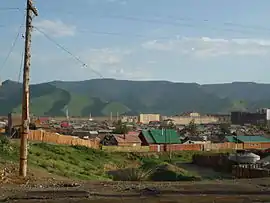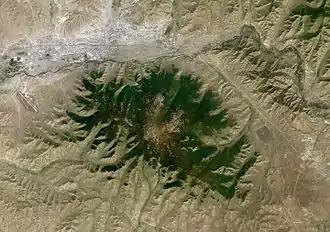Bogd Khan Uul Biosphere Reserve
Bogd Khan Uul Biosphere Reserve is a nature reserve in Mongolia, situated to the south of Ulan-Bator. It is in the southern part of the forest steppe zone and is in the Khentii Mountains area. It includes Bogd Khan Mountain, and was designated as a UNESCO Biosphere Reserve in 1996.
Description


Bogd Khan has a total area of 67,300 hectares (260 sq mi) and is located between 47°43' to 47°54'N and 106°46' to 107°10'E. Its altitudinal range is between 1,310 and 2,270 m (4,300 and 7,450 ft) above sea level. It consists of a core area of about 41,651 hectares (160.82 sq mi) surrounded by a buffer zone and certain transition areas. The northern slopes of Bogd Khan Mountain are covered with dense coniferous forests while the southern side is bare rock.[1]
History
Environmental protection on Bogd Khan Mountain dates back at least to the thirteenth century when the Tooril Khan ruler of the Keraites, forbade logging and hunting there, claiming that Bogd Khan was a holy mountain.[1] Since then, the mountain has been venerated, and local people neither hunted on the mountain nor harvested the timber. In 1778 the Mongolian governor of what is now Ulan-Bator, petitioned the Qianlong Emperor requesting approval to hold twice yearly ceremonies dedicated to Mount Bogd Khan Uul. Permission was granted eight days later for ceremonies to be held twice annually.[2] In 1783, the local government of the Qing dynasty declared the Bogd Khan a protected site, to be preserved for its beauty, making it the oldest national park in the world.[3][4]
Bogd Khan Uul was declared a biosphere reserve by UNESCO in 1996.[1] A biosphere reserve aims to "develop and implement sustainable development approaches" and encourage "ecological and cultural diversity", by integrating the needs of local communities with the preservation of the environment.[5] The core area is strictly protected, the buffer zone is used for activities that are compatible with good ecological practices and the transition zone allows ecologically sustainable activities to take place.[6]
Flora and fauna
The reserve has a number of habitat types including grassland, taiga vegetation, Alpine tundra and bare rock. In some areas there are mixed forest with larch (Larix sibirica), birch (Betula spp.), "Pinus sibirica" ("cedar" common Russian name) (Pinus spp.), pine (Pinus spp.) and poplar (Populus spp.).[1]
Some of the most threatened mammals in the reserve are the musk deer (Moschus moschiferus), the roe deer (Capreolus capreolus), the sable (Martes zibellina) and the Arctic hare (Lepus timidus).[1]
References
- "Bogd Khan Uul". Biosphere Reserve Information: Mongolia. UNESCO. 10 December 2007. Retrieved 18 November 2015.
- "Documents on worshipping Khan Uul" (in Mongolian). Mongolian Governmental Implementing Agency. Retrieved 18 November 2015.
- Bonnett, Alastair (2015). The Geography of Nostalgia: Global and Local Perspectives on Modernity and Loss. Routledge. p. 68. ISBN 978-1-134-68616-2.
- Gunin, P.D.; Vostokova, Elizabeth A.; Dorofeyuk, Nadezhda I.; Tarasov, Pavel E.; Black, Clanton C. (2013). Vegetation Dynamics of Mongolia. Springer Science & Business Media. p. 188. ISBN 978-94-015-9143-0.
- "World Network of Biosphere Reserves". Ecological Sciences for Sustainable Development. UNESCO. Retrieved 18 November 2015.
- "MAB leaflet 2015" (PDF). UNESCO. Retrieved 18 November 2015.